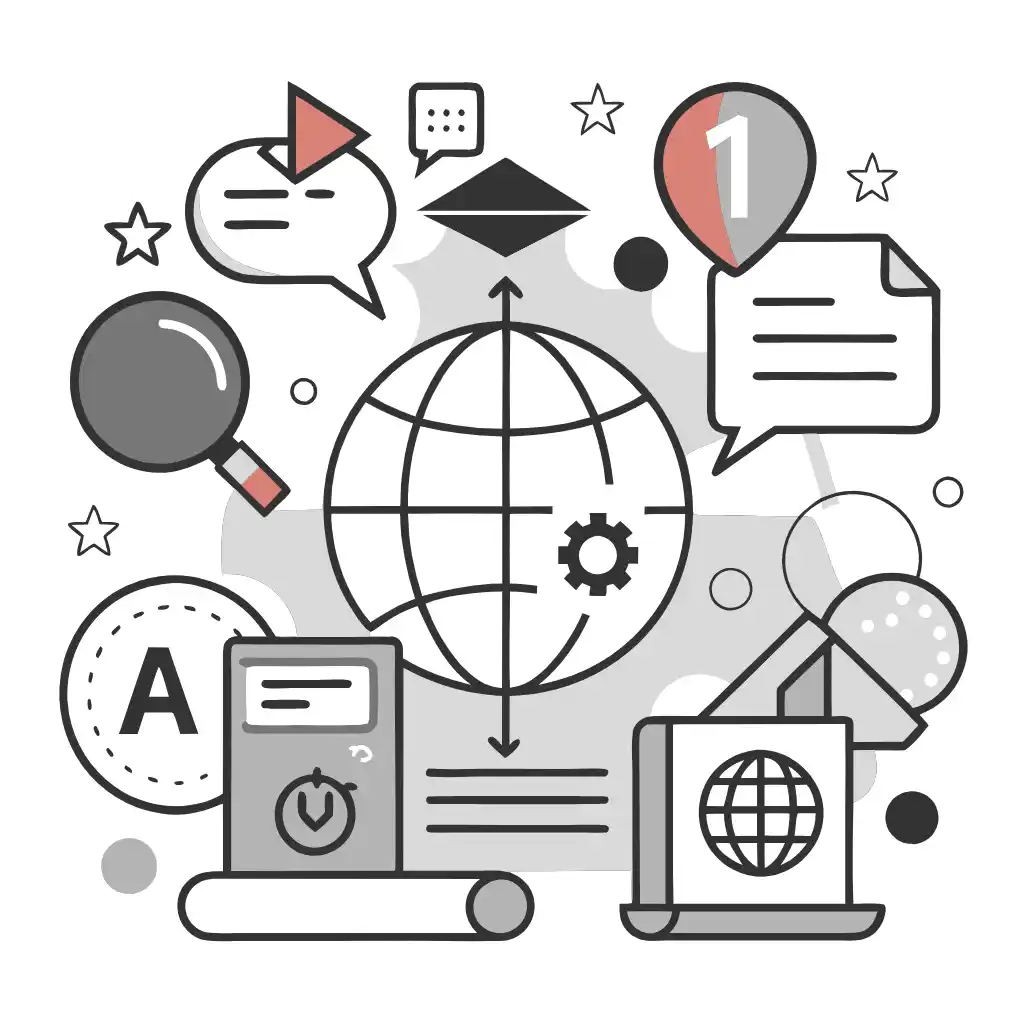신경망 기계 번역의 부상
최근 몇 년 동안 기계 번역 기능이 빠르게 발전하여 신경망 기계 번역이 가장 정교한 기술로 부상했습니다. 복잡한 딥 러닝 알고리즘과 인공 지능을 사용하여 종종 인간 수준과 일치하거나 초과하는 놀라운 고품질 자동 번역을 제공합니다.
신경 기계 번역은 이중 언어 텍스트의 대규모 데이터 세트에서 다층 신경망을 훈련하여 작동합니다. 기계 학습 모델은 방대한 수의 전문 번역을 분석하여 패턴을 추론하고, 규칙을 파악하고, 언어적 뉘앙스를 이해하고, 모든 언어 쌍 간에 텍스트를 번역하는 최적의 방법을 결정할 수 있습니다.
최첨단 신경망을 활용하는 두 가지 주요 서비스는 Google Translate와 DeepL입니다. Google 번역은 Google의 독자적인 신경 엔진을 활용하여 텍스트를 100개 이상의 언어로 놀라운 정확도로 번역합니다. DeepL은 경쟁 우위로서 정밀 번역에 중점을 둡니다. UN과 같은 기관의 거대한 이중 언어 텍스트 데이터베이스에서 고도로 최적화된 신경망을 훈련하여 DeepL이 미묘한 뉘앙스도 정확하게 처리할 수 있도록 합니다.
기계 학습 알고리즘의 지속적인 발전과 교육 데이터의 증가는 자동 번역 기능의 빠른 개선을 지속적으로 주도하고 있습니다. 이제 신경망을 통해 기업은 고품질을 유지하면서 대규모로 콘텐츠를 비용 효율적으로 번역할 수 있습니다. 이를 통해 조직은 온라인 입지를 현지화하여 글로벌 시장에 참여할 수 있는 새로운 기회를 얻을 수 있습니다.

DeepL과 Google 번역의 주요 차이점
높은 수준에서 Google Translate가 더 광범위한 언어 지원과 더 큰 대중적 가시성을 제공하는 반면, DeepL은 더 큰 전반적인 번역 정확도와 품질을 제공하는 데 명성을 걸고 있습니다. 독립적인 제3자 평가에 따르면 DeepL은 영어에서 독일어, 프랑스어, 스페인어와 같은 언어로의 번역을 평가하는 직접 대결 테스트에서 Google Translate보다 상당히 우수한 것으로 나타났습니다.
이 이점은 범위보다는 완벽에 대한 DeepL의 단일 초점에서 비롯된 것 같습니다. 이 회사는 Google과 같은 100개 이상의 언어에서 더 크지만 잠재적으로 희석된 교육 접근 방식을 추구하는 대신 지원하는 언어 쌍에 대해 최고 품질의 결과를 짜내기 위해 신경망의 모든 측면을 최적화한 것으로 보입니다.
DeepL은 Windows 및 Mac용 독립 실행형 데스크톱 애플리케이션을 제공함으로써 소비자 분야에서 약간의 우위를 점하고 있는 반면 Google Translate는 주로 웹 및 모바일 기반입니다. 그러나 대부분의 사용 사례에서 두 가지 시장 선도적 옵션은 기능과 기능 면에서 광범위하게 비슷한 것으로 보이며 DeepL은 특히 정밀 기계 번역 품질에 대한 최적화 노력을 기울였습니다. 이는 주로 정확성에 중점을 둔 사용자에게 우위를 제공합니다.
올바른 기계 번역 접근 방식 선택
특정 비즈니스에 이상적인 기계 번역 솔루션을 결정하는 것은 해당 비즈니스의 구체적인 요구 사항과 우선순위에 따라 크게 달라집니다. 영어에서 스페인어, 프랑스어 또는 독일어와 같은 일반적인 언어 쌍의 경우 DeepL은 수행된 연구에 따르면 확실히 정확도가 더 높은 것으로 보입니다. 그러나 보다 틈새 언어 쌍의 경우 Google이 100개 이상의 언어를 지원하여 우위를 점합니다.
단일 공급업체에만 묶이는 것보다 가장 신중한 전략은 여러 기술을 결합한 유연하고 하이브리드적인 접근 방식을 채택하는 것입니다. 웹사이트 번역의 경우 ConveyThis과 같은 플랫폼은 DeepL과 Google Translate, Microsoft Translator 및 Yandex를 포함한 다양한 선도적인 신경망 번역 엔진을 원활하게 통합하여 이러한 철학을 보여줍니다. 각 언어 쌍과 콘텐츠 유형의 고유한 요구 사항에 따라 ConveyThis은 최상의 번역 정확도와 결과를 제공할 가능성이 가장 높은 최적의 엔진을 동적으로 결정하고 선택합니다. 이러한 사용자 지정 가능한 조건부 접근 방식을 통해 각 기술의 상대적인 강점을 활용하고 전문화를 통해 약점을 최소화할 수 있습니다.


웹사이트에 대한 ConveyThis의 주요 이점
자동화된 웹사이트 번역 플랫폼인 ConveyThis은 여러 가지 고유한 이점을 제공합니다. WordPress, Shopify, Wix 등을 포함한 모든 주요 콘텐츠 관리 시스템 및 플랫폼과 원활하게 통합됩니다. 이를 통해 복잡한 맞춤형 소프트웨어 개발을 피할 수 있습니다. 단독 텍스트가 아닌 전체 웹사이트의 자동 번역. 이 솔루션은 로컬라이제이션을 위해 페이지에서 모든 텍스트 콘텐츠를 크롤링하고 추출합니다. 우선순위에 따라 인간의 사후 편집을 통해 원시 기계 출력을 정제하는 검토 및 편집 기능. 자동화 블렌딩과 전문가 요구 사항을 모두 위한 전문적인 인간 번역 서비스에 대한 API 액세스. URL 구조, hreflang 태그 및 검색 엔진 인덱싱을 포함한 다국어 SEO 모범 사례의 자동 구현. 플랫폼 대시보드 내에서 번역된 페이지를 시각적으로 미리 보고 콘텐츠 무결성을 검증하는 기능. 사용자 역할 및 권한과 같은 협업 도구는 팀과 외부 번역자가 웹사이트 로컬라이제이션을 관리하는 데 도움이 됩니다. 지속적인 엔진 개선 모니터링 및 번역 품질 테스트를 통해 시간이 지남에 따라 최적의 결과를 보장합니다.
다양한 인공신경망 기계 번역 기술과 인간 번역의 전략적 융합을 통해 전문적이면서도 비용 효율적인 웹사이트 현지화 기능을 제공할 수 있습니다.
ConveyThis의 성공 사례 및 사용 사례
다음은 웹사이트를 번역하는 고객에게 ConveyThis이 제공한 영향을 강조하는 몇 가지 실제 사례입니다. 고급 의류 및 액세서리를 판매하는 유럽 전자상거래 사이트에서는 ConveyThis를 사용하여 150개 이상의 복잡한 제품 카탈로그를 번역했습니다. 3개 언어로. 통합부터 실행까지 전체 프로세스가 15일도 채 걸리지 않았습니다. 이후 해외 웹사이트 방문 횟수가 400% 이상 증가했습니다. 기술 지원 콘텐츠에 대한 상당한 지식 기반과 주제 전문가의 주간 블로그 업데이트를 갖춘 글로벌 SaaS 회사는 수동으로 기사를 번역하는 데 주당 4시간 이상을 소비했습니다. ConveyThis를 구현하여 번역 처리 시간을 30분으로 줄이면서 출력량을 늘렸습니다. 유럽의 한 선도적인 럭셔리 패션 브랜드는 독일 독자층을 대상으로 온라인 잡지의 트래픽을 확대하고자 했습니다. ConveyThis를 통합하고 새 기사 번역을 자동화한 후 2개월 이내에 독일 블로그 트래픽이 120% 증가했습니다.
다양한 사용 사례와 수직 시장은 자동화된 기계 번역을 통한 웹사이트 현지화가 해외 고객과 연결하여 업계 전반에 엄청난 가치를 제공할 수 있음을 보여줍니다.

기계 번역 성공을 극대화하기 위한 전문가 권장 사항
오늘날 최고의 기계 번역 서비스를 통해 규모에 맞는 품질을 달성할 수 있지만, 영향력을 극대화하려면 신중한 프로세스와 전략이 여전히 중요합니다. 자동 번역을 구현할 때의 주요 전문가 권장 사항은 다음과 같습니다. 언어당 최소 30~50개의 핵심 웹사이트 페이지에 대해 고품질 인간 번역의 견고한 기반을 확보하는 것으로 시작합니다. 이를 통해 신경 엔진에 사이트의 용어와 스타일에 적응하는 데 필요한 필수적인 교육 데이터를 제공합니다. 데이터 중심 비즈니스 우선순위와 준비된 인간 번역 페이지의 양에 따라 점진적으로 언어 롤아웃을 단계적으로 수행합니다. 특정 시장은 집중적인 시작이 필요할 수 있습니다. 다국어 SEO 모범 사례를 참조하고 인덱싱을 위해 처음부터 hreflang 태그와 같은 주요 최적화를 구현합니다. 지속적인 교육을 통해 기계 정확도를 개선하기 위해 대상 언어로 인간 번역 페이지를 지속적으로 확장합니다. 분석을 모니터링하여 언어별 참여 수준과 ROI를 파악하여 투자를 안내합니다. 데이터를 통해 우선순위를 알립니다. 인간 번역을 요청하고 관리하는 프로세스를 개선하여 고가치 페이지에 노력을 집중합니다. 최적화를 추구합니다. 인간 및 자동화된 품질 검사를 모두 사용하여 출력을 검증합니다. 수정 루프를 구현합니다.
적절한 전략적 기반과 워크플로가 구축되면 기계 번역은 현지화된 웹사이트와 콘텐츠의 출시를 획기적으로 가속화하는 확장 가능한 자산이 됩니다.
기계 번역 기술의 미래
오늘날 이미 매우 유능하지만, 기계 번역 솔루션은 연구가 진행됨에 따라 앞으로 몇 년 동안 필연적으로 발전하고 개선될 것입니다. 지평선에 있는 몇 가지 주요 혁신은 다음과 같습니다. 텍스트를 넘어선 문맥 인식 증가. 엔진은 단순히 문서를 분석하는 대신 실제 지식과 메타데이터를 통합하여 이해력을 향상시킬 수 있습니다. 더욱 정교해짐에 따라 감정, 톤 및 암시된 의미와 같은 언어적 뉘앙스를 더욱 정확하게 처리합니다.
Wikipedia 자원 봉사 번역과 같은 소스에서 얻은 광범위한 데이터에 대한 시스템 교육을 통해 덜 일반적인 틈새 언어에 대한 지원 확대. 집중된 데이터 세트를 통해 법률, 의료 및 기술 문서 작성과 같은 고가치 도메인에서 더 강력한 성능과 전문화된 능력. 비디오, 음성 및 IoT의 수요 증가로 인해 멀티미디어 콘텐츠, 대화형 인터페이스 및 음성 번역과의 긴밀한 통합. 더 빠른 휴먼 하이브리드 검토를 위해 사용하기 쉬운 편집 도구를 통해 크리에이티브 워크플로에 대한 향상된 통합.
그러나 오늘날 대부분의 실용적인 비즈니스 사용 사례에서 신경망 기계 번역은 이미 다국어 웹사이트 현지화에 대한 뛰어난 가치와 ROI를 제공할 만큼 충분히 성숙했습니다. 이 기술은 적절하게 구현하면 외국 청중과의 교류를 통해 상당한 국제적 성장과 기회를 창출할 수 있습니다.

결론
요약하자면, DeepL과 Google Translate와 같은 오늘날 최고의 신경망 기계 번역 서비스는 기업이 상당한 규모로 웹사이트를 비용 효율적으로 현지화할 수 있는 입증된 수단을 제공합니다. 조직은 자동 번역을 채택함으로써 마침내 전 세계 비영어권 인터넷 사용자의 엄청난 잠재적 수요를 활용할 수 있습니다.
번역은 단순히 언어를 아는 것 이상으로 복잡한 과정입니다.
팁을 따르고 ConveyThis을 사용하면 번역된 페이지가 대상 언어에 익숙하지 않은 사람들에게 공감을 불러일으키고 원어민 같은 느낌을 줄 수 있습니다.
노력이 필요하지만, 그 결과는 보람이 있습니다. 웹사이트를 번역하는 경우, ConveyThis은 자동화된 기계 번역으로 몇 시간을 절약할 수 있습니다.
ConveyThis를 7일 동안 무료로 사용해 보세요!